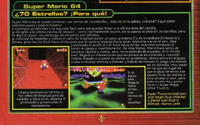Club Nintendo (Mexican magazine)
This article does not cite any sources. Unsourced material may be challenged and removed. Specific(s): Historical information needs to be corroborated with external sources.
Please help improve this article by adding citations from reliable sources.
It has been requested that more images be uploaded for this article. Remove this notice only after the additional images have been added. Specific(s): Add Super Mario covers and artwork

Club Nintendo, shortened to CN or ClubNin, was the official magazine of Nintendo for Mexico and the rest of Latin America. It was created by Gustavo "Gus" Rodríguez and José "Pepe" Sierra. Editorial Televisa was its publisher until February 2019, where due to financial problems of the editorial, its publication was immediately stopped for those Latin American countries where it was still published (Venezuela, Colombia, Peru, Ecuador, Argentina, and Chile in monthly physical format), adding to its digital version.
In December 2011, the magazine celebrated its 20th anniversary and in December 2014 they published their last issue in monthly physical format in Mexico.
Development and history
In 1987, two advertising executives and gamers, Gus Rodríguez and Pepe Sierra, formed an agency called Network Publicidad. In 1988, they acquired an NES along with Super Mario Bros. and The Legend of Zelda, when these were not very well known in Mexico, and thus began their love for Nintendo and its works.[1]
In 1989, Jorge Nogami, about to open an official Nintendo store in Mexico City, called Gus and Pepe to do some advertising for him. Instead of making ads for radio and newspapers, they decided to publish a bi-weekly newsletter called El Mundo de Nintendo (Nintendo's World), which contained information about the best-selling titles, tips and tricks. The newsletter started with four pages and two inks, was letter-sized, folded in three and included almost no photos or images since most had to be done by hand.[2]
The newsletter became so popular in the store that it quickly grew to eight pages and three inks, and special editions of some games such as Super Mario Bros. and Super Mario Bros. 3 were also made. Some time later, two new members nicknamed Axy and Spot joined the team (contributing with a section called Warp Zones), as were Jesús Medina "Chucho" and Adrián Carbajal "Carqui".
In July 1991, Teruhide Kikuchi, a Japanese executive from Itochu (formely C. Itoh & Co.), then the official distributor of Nintendo in Mexico, called Network Publicidad and Ediciones Continentales to create a magazine to inform about and promote Nintendo products.
Then they began to work on a prototype to show to Kikuchi, choosing the one made by Network Publicidad since Ediciones Continentales was planning to make a hobby magazine. Thus, the meetings for the magazine's creation began, where some names were proposed for it such as El Club de Nintendo, which was Kikuchi's final choice. Thus, on December 8, 1991, the first issue of the magazine came out under the name Club Nintendo.
During the first years the magazines were stapled together, covers were airbrushed on cardboard four times the original size, pictures of the games were taken with a camera directly from the monitor with the Game Boy's games were photocopied from the screen, other images were hand-drawn and maps were drawn on albaneno paper with a stylograph and colored with markers.
Over time, the magazine underwent several changes in style and format, it began to be bound, more pages were added, new sections began to appear and special editions began to be released. In addition, the magazine organized several parties, meetings, tournaments and attended many events such as the CES, the E3 and the EGS. They also usually give away consoles, games and other items related to Nintendo or the magazine during special events or promotionals posted in the magazine.
It was with the issue of December 2014 (Super Smash Bros. for Nintendo 3DS / Wii U on the cover) that the magazine stopped its monthly publishing for Mexico's market, meanwhile in countries like Chile or Peru continued this format of publishing until its cancellation in February 2019. An issue was planned for March 2019 with Yoshi's Crafted World as the main article, but it was canceled too.
With this, the magazine ended with a record of 263 issues and more of 13 special editions.
Content
The magazine had various sections that disappeared or returned with some regularity. The most notable examples are:
- D℞. MARIO: Column of questions sent by mail, traditional or electronic, with answers by Dr. Mario himself.
- Canales Nintendo (Nintendo Channels): Where the content of WiiWare's games is summarized.
- CN Profile: A detailed summary of Nintendo-related characters.
- Mariados: Where readers sent their questions regarding secrets or parts of videogames that are difficult to overcome or discover.
- S.O.S. - Servicio Organizado de Secretos (Service of Organized Secrets): Several lists of videogames with tricks to obtain unlockable content.
- Un Vistazo a Japón (A Glimps of Japan): Section dedicated to the culture of Japan, things such as manga, anime or videogames that are popular there and/or that have never been released outside that market.
- Los Años Maravillosos (The Wonderful Years): Section dedicated to remembering Nintendo's consoles from the past and some of their most memorable games.
- Galería CN (CN Gallery): Where readers can send their fanarts by traditional mail.
List of Super Mario game reviews
Gallery
Third logo, variation inspired by Super Mario World 2: Yoshi's Island
1st year, issue no. 1
Mario landing by parachute near of the Angel of Independence in Mexico City
Trivia
- Although it was already known even before the release of the game in the Western side of the world, the November 2000 edition (Year 9, Issue no. 11) was the first to officially document the existence of the Backwards Long Jump glitch from Super Mario 64.





